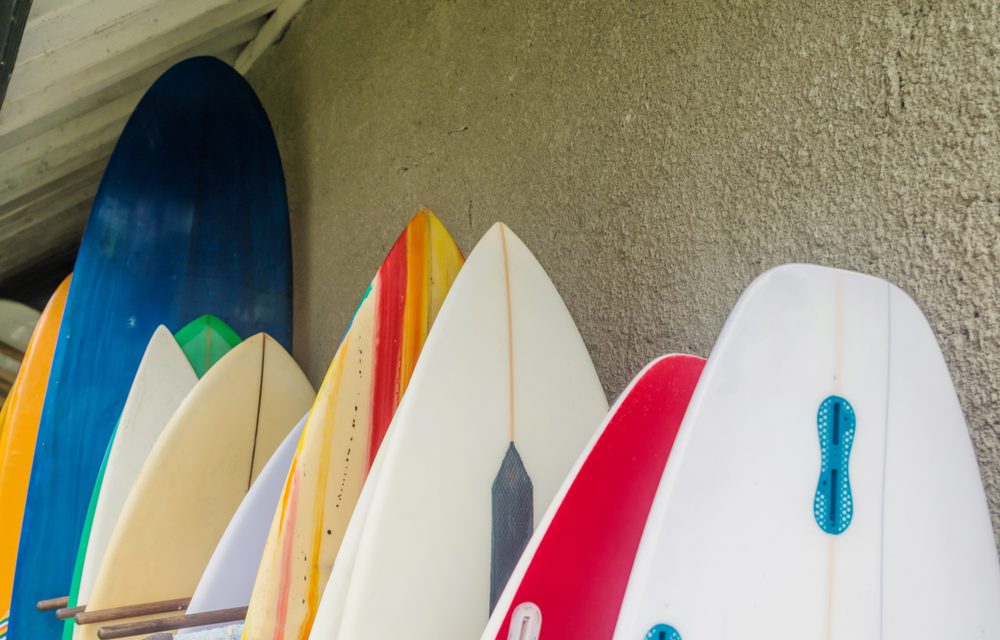For many passionate surfers, the closest thing to nirvana is being out of the water, waiting for that perfect wave to hit. The tools of your trade are your surfboard, wetsuit, and patience.
When the cooler weather arrives, you may need to hang up your surfboard and wetsuit for the season. Treat these items like the valuable possessions they are with proper wetsuit and surfboard storage. After all, a high-quality wetsuit can easily cost a few hundred dollars, while surfboards can set you back between $600 and $800.
Proper board and wetsuit storage in the offseason will increase the lifespan of your equipment, saving you money in the long run and giving you more chances at nirvana with the equipment you already know and love.
Part 1: Show Your Surfboard Some Love
Taking the right steps to store your surfboard can mean the difference between finding it in pristine condition or discovering costly damage when you’re ready to paddle out again. Here’s what surfers need to know.
Clean Your Board Before Storage
Before storing your surfboard for any extended period, give it a thorough clean. Salt water can cause corrosion over time, while leftover sand can scratch your baby.
Start by removing old wax using a wax comb or plastic scraper. Then, clean the entire board with fresh water and a mild soap to get rid of salt deposits. Let the board completely dry. Any trapped moisture can cause mold, foam rot, or delamination during storage.
Store in the Right Climate
Temperature stability is the key to keeping your board in good condition during storage. Extreme heat or cold can cause the foam core to expand and contract.
Don’t store your board in direct sunlight, attics, garages, or car trunks where temps can soar. Your ideal storage location should maintain a consistent, moderate temperature and humidity level. Think: interior closets or climate-controlled storage units.
Good Board Position and Support
Never lean your surfboard against a wall at a steep angle for a long period of time. This can cause the nose or tail to develop flat spots or the board to take on an unwanted bend. Your best approach is to store your boards horizontally on padded racks that support each board at multiple points.
If horizontal storage isn’t possible, store your board vertically with padding at the contact points. Place soft padding between each board to prevent dings and scratches.
Add an Extra Layer of Protection
Even in storage, your boards can collect dust or get scratched if items shift. To give your gear an extra layer of protection (and yourself some extra peace of mind), put your boards in a board bag or surfboard sock.
Don’t have a surfboard bag or sock? You can also wrap your boards in old towels or blankets.
Part 2: Wetsuit Care and Storage for Maximum Longevity
Wetsuits are made from neoprene, a specialized synthetic fabric that needs specific care to maintain its flexibility, insulation properties, and structural integrity. Many surfers unknowingly damage their wetsuits through improper storage techniques, which can lead to cracking, loss of stretch, and reduced thermal efficiency.
The good news is that the right type of wetsuit care and storage can keep your suit in peak condition for years to come.
Rinse and Clean Thoroughly
Salt water, sand, and organic debris can break down your neoprene wetsuit over time. Rinse your wetsuit with fresh, cool water after every use. Turn your suit inside out and rinse the interior, and pay special attention to the zippers and seams where sand can collect.
Before long-term wetsuit storage, use a wetsuit-specific cleaner or shampoo to remove built-up oils and bacteria. After cleaning, rinse your wetsuit thoroughly to remove all soap residue.
Dry Your Wetsuit Completely
You never want to put your wetsuit into storage while it’s still damp. That can lead to mold, mildew, and material breakdown (not to mention a bad-smelling suit).
When drying your wetsuit, fold it over a wide, padded hanger or lay it flat on a clean surface. Hanging your suit by the shoulders can permanently stretch it.
Try not to dry your suit in direct sunlight or high heat. Both of these elements can break down your wetsuit, causing it to become brittle and lose elasticity. Give your wetsuit anywhere from 24-48 hours to fully dry.
Store in the Right Environment
When it’s time for long-term wetsuit storage, keep your suit out of direct sunlight and choose a storage area with moderate temperatures. UV light can fade your suit and break down neoprene. Extreme temperature swings can also damage your wetsuit material and even cause it to crack.
As with your surfboard, you want to avoid storing your wetsuit in garages, attics, and car trunks. Consider an indoor closet or climate-controlled storage unit.
Store Your Wetsuit the Right Way
For short-term storage, you can get away with hanging your wetsuit on a padded hanger or folding it over a thick towel on a regular hanger. For seasonal storage, however, you’ll get the best results by storing your wetsuit flat.
Lay the suit flat in a drawer, on a shelf, or in a clean storage container with minimum folding. If you do need to fold your suit, fold along natural body lines to avoid creating permanent creases.
Never store your wetsuit in plastic bags, as this can trap moisture and prevent natural air circulation. Instead, put them in breathable garment bags.
The Best Spot: Where to Store Your Gear
Let’s not skate (surf?) around the issue. Surfboards are, well, big. That can make storing them in your home challenging, especially if you are looking to store multiple boards in the off-season. As mentioned earlier, while the garage or attic may be tempting storage options, they’re not ideal due to the potential for temperature extremes.
If you want top-notch surfboard storage that frees up space in your home, consider renting a climate-controlled storage unit. Even small units can hold several surfboards along with your wetsuits and other summer gear, like beach chairs, umbrellas, coolers, and spikeball set.
Count on Price Self StorageⓇ for flexible and competitively priced storage. We offer month-to-month leases, perfect for seasonal storage. Select locations also include climate-controlled units, so your surfboard and wetsuit will stay in pristine condition until nirvana calls again.
Find your nearest Price Self Storage.
Wetsuit and Surfboard Storage FAQs
Can I store my surfboard standing up?
Yes, you can store your surfboard standing up, but it’s not ideal for long-term storage. Vertical storage can cause pressure points and warping over time. For extended storage, lay boards horizontally on padded racks with multiple support points.
What’s the biggest mistake people make when storing wetsuits?
The biggest mistake surfers make is storing a wet or damp wetsuit. Trapped moisture in the neoprene can lead to mold, mildew, bad odor, and degradation of the wetsuit material. Always make sure your wetsuit is completely dry before storing it.
Is a climate-controlled unit really necessary?
While not strictly necessary for wetsuit or surfboard storage, climate-controlled storage units can help extend the lifespan of your valuable surf equipment. Extreme temperatures can damage surfboard foam cores, cause delamination, and make wetsuits brittle.
Should I take the fins off my board for storage?
Yes, it’s a good idea to take the fins off your surfboard before storing it. Fins can break off if the board is accidentally bumped or shifted, so it’s best to store your board fins separately in a protective case or wrap them in padding.
How should I store multiple boards together?
Your best option is to store multiple surfboards horizontally on padded racks with soft padding between each board to prevent dings or scratches. Try to avoid stacking boards directly on top of each other. Use towels, foam pads, or board bags as barriers.










